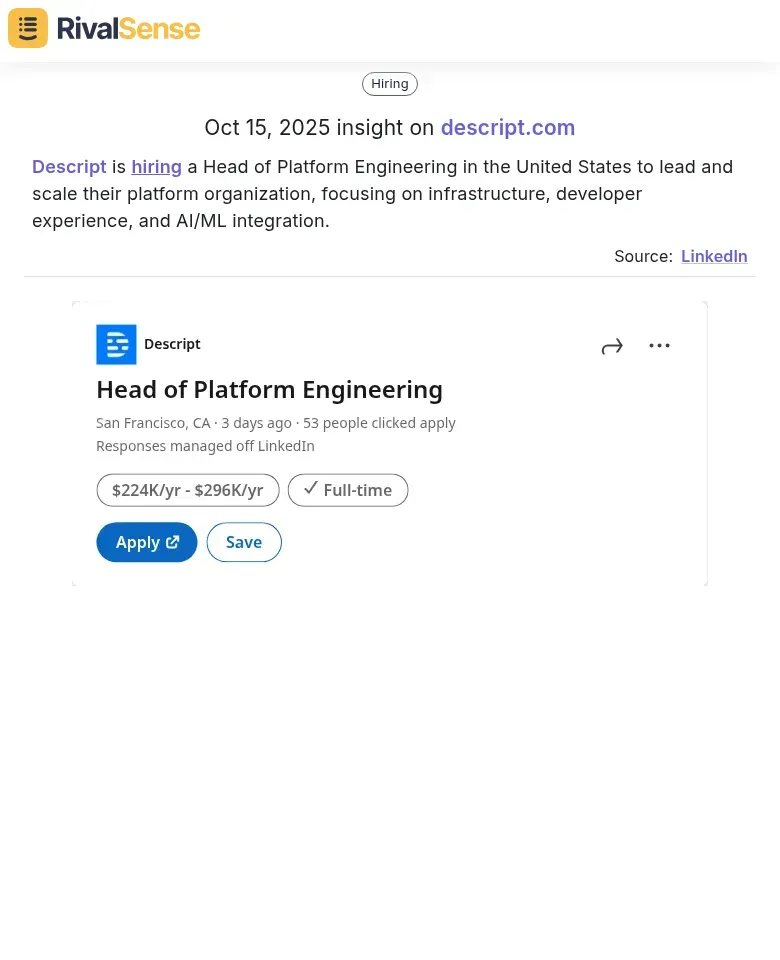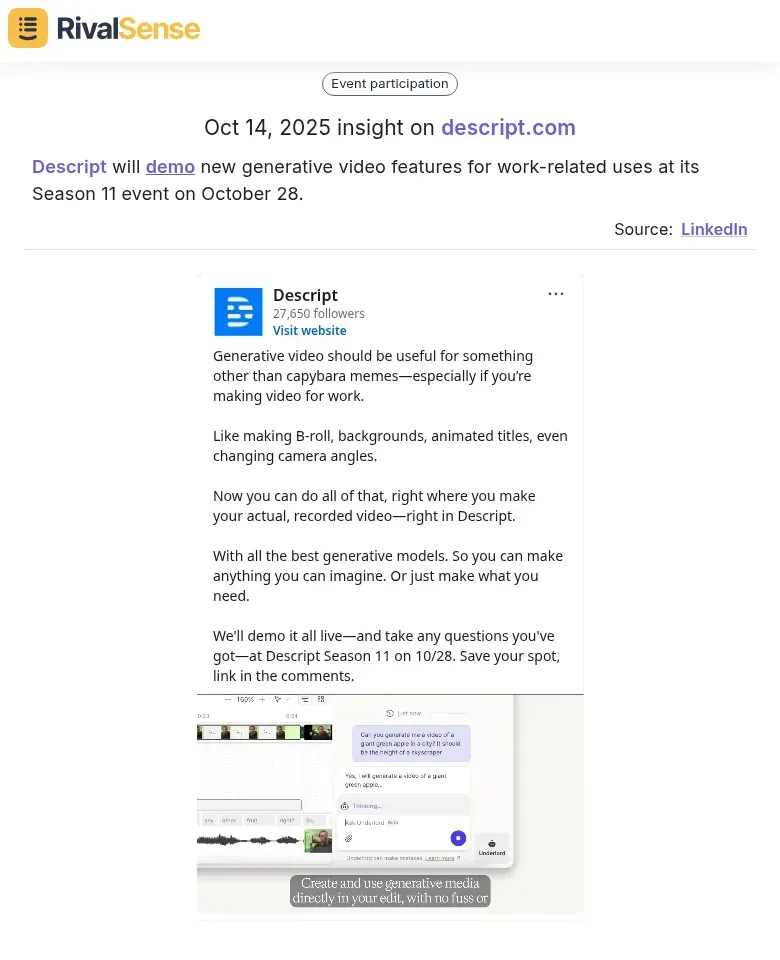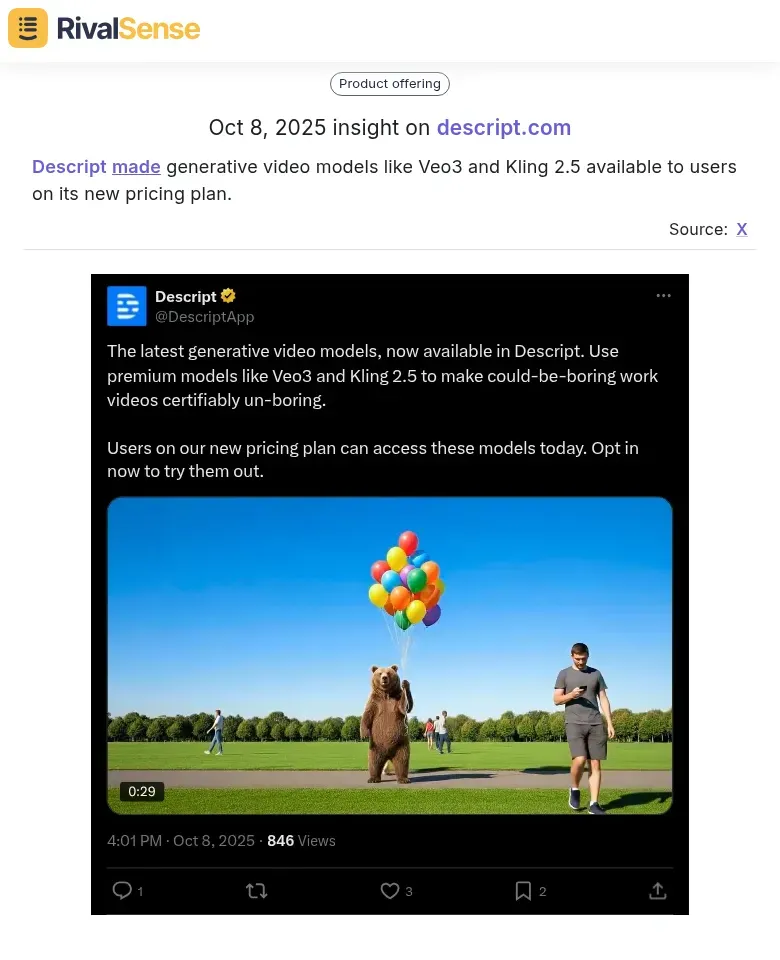Media Industry Key Account Tracking: Your Strategic Cheat Sheet
In the fast-paced media industry, tracking key accounts isn't just beneficial—it's essential for strategic decision-making. By monitoring competitors' major clients and partnerships, media companies gain critical insights into market dynamics, helping anticipate shifts in content consumption, advertising trends, and technological innovations. This proactive approach enables businesses to adapt their strategies, identify emerging opportunities, and mitigate risks before they impact revenue.
However, common challenges like fragmented data sources, information overload, and the rapid pace of product launches can hinder effective tracking. To overcome these, start by identifying your top 5-10 competitor accounts to monitor regularly. Use tools like RivalSense to automate tracking of client announcements, partnership changes, and product updates. Create a simple checklist: weekly reviews of competitor press releases, quarterly analysis of client portfolios, and alerts for any major account wins or losses. This disciplined approach transforms raw data into actionable intelligence, keeping you ahead in the competitive media landscape.
Learning from Competitor Hiring and Organizational Moves
Competitor hiring patterns reveal strategic priorities before they're publicly announced. Leadership hires like Chief AI Officers signal long-term technology bets, while roles such as Head of Platform Engineering indicate infrastructure investments for scalability. For example, RivalSense recently tracked that Descript is hiring a Head of Platform Engineering in the United States to lead and scale their platform organization, focusing on infrastructure, developer experience, and AI/ML integration.  This type of insight is valuable because it provides early warning of a competitor's focus on scaling operations and integrating advanced technologies, allowing you to anticipate their infrastructure upgrades and adjust your own talent strategy accordingly.
This type of insight is valuable because it provides early warning of a competitor's focus on scaling operations and integrating advanced technologies, allowing you to anticipate their infrastructure upgrades and adjust your own talent strategy accordingly.
Practical Checklist:
- ✅ Monitor job postings for emerging roles and required skills
- 📈 Track leadership movements through press releases and LinkedIn
- 🏢 Analyze reporting structures to understand strategic focus areas
- 📊 Benchmark workforce composition against industry peers
Key Insights:
- 🔍 Multiple senior AI hires = preparing for product innovation
- 🌍 Geographic hiring clusters = market expansion plans
- ⚙️ Platform engineering roles = infrastructure scaling phase
- ⚠️ High attrition in specific departments = potential internal challenges
Use tools like RivalSense to automate competitor workforce tracking and gain 3-6 month lead time on strategic shifts.
Analyzing Competitor Product Launches and Feature Demos
When analyzing competitor product launches and feature demos, focus on extracting actionable intelligence. Start by monitoring event announcements and demo videos systematically to identify trends and gaps in the market. For instance, RivalSense insights show that Descript will demo new generative video features for work-related uses at its Season 11 event on October 28.  Tracking such demos is crucial as it uncovers real-time innovation efforts and market positioning, enabling you to refine your product roadmap and counter with timely updates.
Tracking such demos is crucial as it uncovers real-time innovation efforts and market positioning, enabling you to refine your product roadmap and counter with timely updates.
Practical Steps:
- Create a launch tracker spreadsheet with columns for:
- Product name
- Launch date
- Key features
- Target audience
- Messaging
- Analyze demo content: What problems do they solve? How do they position AI capabilities? Look for gaps in their offerings.
- Use launch timing insights to refine your roadmap—if competitors launch before major conferences, consider preemptive feature releases.
- Adjust marketing positioning based on competitor messaging; if they highlight speed, emphasize your product's accuracy or customization.
Checklist for Each Competitor Launch:
- 📅 Record launch date and context
- 📝 Document featured capabilities and AI integration
- 🎯 Identify target user pain points addressed
- 🔄 Compare with your roadmap for overlap or gaps
- 🚀 Update competitive positioning strategy
This approach turns competitor activity into strategic foresight, helping you stay ahead in the dynamic media industry.
Decoding Pricing and Accessibility Strategies
When tracking media industry competitors' pricing strategies, focus on how new plans impact market accessibility and user adoption. Pricing changes often reflect broader business goals, such as market penetration or premium positioning. For example, RivalSense identified that Descript made generative video models like Veo3 and Kling 2.5 available to users on its new pricing plan.  Insights into pricing adjustments are valuable because they reveal how competitors are responding to cost pressures or expanding their addressable market, helping you optimize your own tiers and avoid pricing missteps.
Insights into pricing adjustments are valuable because they reveal how competitors are responding to cost pressures or expanding their addressable market, helping you optimize your own tiers and avoid pricing missteps.
Practical Checklist:
- 📊 Monitor plan changes quarterly
- 🔍 Analyze feature availability across tiers
- 💬 Survey customer feedback on affordability
- 🎯 Assess competitor focus: growth-oriented vs. premium-heavy
Use this data to anticipate market shifts and adjust your pricing to stay competitive, ensuring you don't miss opportunities in evolving accessibility landscapes.
Implementing a Proactive Competitor Tracking Framework
Implementing a proactive competitor tracking framework is essential for media companies to stay agile and responsive to market changes. Begin by defining your key accounts and industry players, including direct competitors, emerging disruptors, and complementary businesses. Use tools like RivalSense to automate monitoring of hiring trends, product updates, and pricing shifts, setting up alerts for real-time notifications to ensure you never miss a critical development.
Key Metrics to Track:
- 👥 Employee growth rates
- 🚀 Feature release frequency
- 💰 Pricing elasticity
Integrate insights by holding monthly strategy reviews where teams discuss findings and adjust campaigns, product roadmaps, or pricing tiers. For example, if a rival hires data scientists, ramp up your own AI initiatives.
Framework Checklist:
- ✅ Identify 5-10 key players
- 🛠️ Select tracking tools (e.g., RivalSense)
- 📈 Define KPIs
- 📅 Schedule reviews
- 🎯 Act on insights
This systematic approach turns raw data into competitive advantage in the fast-moving media landscape.
Conclusion: Turning Insights into Competitive Advantage
In the fast-evolving media industry, continuous key account tracking transforms raw competitor intelligence into sustainable competitive advantage. By systematically monitoring rival client portfolios, win-loss patterns, and service innovations, you can anticipate market shifts before they disrupt your business. This proactive approach drives innovation by revealing unmet client needs and emerging opportunities, while simultaneously mitigating risks through early warning of competitive threats.
Best Practices for Acting on Intelligence:
- 📅 Weekly review of competitor account movements to identify churn patterns
- 📊 Monthly analysis of feature adoption trends to guide product development
- 💰 Quarterly assessment of pricing strategies to maintain competitive positioning
Simple Tracking Checklist:
- 🔍 Track 3-5 key competitor accounts weekly
- 📝 Document 2-3 actionable insights monthly
- 🚀 Implement at least one strategic adjustment quarterly
Foster a culture of proactive monitoring by integrating competitor intelligence into regular team meetings and strategic planning sessions. Encourage cross-functional collaboration between sales, product, and marketing teams to ensure insights translate into tangible improvements.
To streamline your competitor tracking and gain actionable insights like the examples shared, try out RivalSense for free at https://rivalsense.co/. Get your first competitor report today and start turning intelligence into advantage!
📚 Read more
👉 Actionable Market Entry Strategies Using Competitor Insights
👉 How to Leverage Competitor Personnel Changes for Strategic Advantage
👉 Unlocking Competitor Pricing Advantages: A Strategic Guide for Business Leaders
👉 Key Account Management Checklist for Elevator & Escalator Maintenance
👉 How Emirates' Fleet Upgrade Revealed Competitors' Strategic Moves
